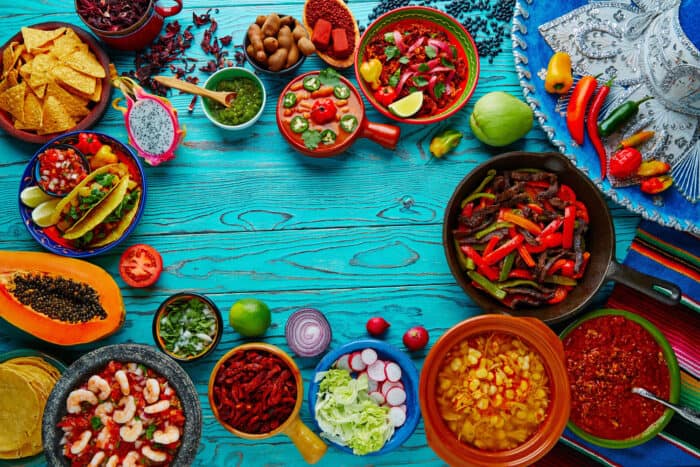
Written By: Sejal Dave, RD
Title: Registered Dietitian
Alumni: University of Florida
Last Updated on:

Let’s face it, eating out is something we all like to do. It’s relaxing, convenient, and fun to let someone else worry about what to cook. For people with diabetes, it’s important to keep an eye on your plate – whether you’re at home or at a restaurant. It can be a challenge to find healthy options, but it’s possible. Mexican restaurants offers fresh ingredients with big flavors. With careful planning, people with diabetes can enjoy wholesome Mexican foods too.

Table of Contents
Should you order the Grande Chicken Taco Salad or the Chicken Fajita Salad? Or maybe you should you try the Chimichanga? The salads basically sound the same, right? No, not exactly. Both of the salads, from On the Border, are made with chicken and lettuce, but one of them comes in a big (grande) taco shell. The Grande Chicken Salad has about 1,280 calories and 75 grams of carbs, while the Fajita Chicken Salad has about 750 calories and 25 grams of carbs. The fried tortilla shell makes a big difference in calories and the extra large taco shell just provides more carbohydrates! Otherwise, a chicken salad with vegetables and even beans is a healthy diabetes meal option.
Chimichangas, on the other hand, is often deep fried. It clocks in 1,350 calories and 130 grams of carbs. If you are doing carbohydrate-counting, that’s more than 8.5 carb serving. Other smaller dishes, such as empanadas and taquitos, are deep fried tortillas that are filled with meat, cheese, and some veggies. They can be much higher in calories, carbs, and fats than regular tacos and burritos.
At Taco Bell, the Gordita (Spanish for “little fat one”) is wrapped in a thicker pita-style tortilla, which has 340 calories and 30 grams of carbs, compared to 200 calories and 15 grams of carbs in a regular crunchy taco.
Avoid items with mega, grande, double-decker or supreme in their names – you will usually end up with at least 100 more calories per serving than the regular version. Familiarize yourself with descriptions of entrees before you order, as this way you can avoid extra calories and carbs.
Toppings at Mexican restaurants can add big flavor. However, sometimes they may add extra unnecessary carbohydrates (and calories) to otherwise healthy meal options. Taco Bell offers an alternative to high-calorie toppings like cheese/queso and sour cream. Their new fresco menu has tacos, burritos, and salads made with fresh tomatoes, onions, and lettuce. You get great flavor with fewer calories. Likewise, places such as Moe’s Southwestern Grill and Chipotle have “salad bars” where you can pick what goes in and on your food. You have more control over how your food is prepared. So go ahead and eat your grilled chicken taco with a side of black beans, but don’t go overboard with the “icing.”
Yes, alcohol needs to be addressed in your diabetic meal plan. Some drinks are going to have fewer calories than others. A light Mexican beer (for example, Corona Light) has about 110 calories, but a Margarita could have up to 350 calories. Alcohol may cause a delay in blood glucose dip – it is particularly of a concern if you are taking insulin. If you choose to have a drink, drink with a meal consists of some carbohydrate choices to prevent hypoglycemia. The American Diabetes Association recommends that, in general, people with diabetes should have 1 to 2 drinks per day.
Mexican restaurants can definitely be a good option for people with diabetes. They offer low-calorie and low-carb options like beans, grilled veggies, and chicken, not to mention flavorful salsas made with fresh tomatoes, herbs, and spices. Use the following checklists to guide your way.
Alumni: University of Florida – Sejal is a registered dietitian, a certified diabetes educator and she holds a masters degree in nutrition and health. Sejal was the project coordinator for the Veteran’s Administrations (VA) national weight loss program and previously worked for the VA hospital in Tampa, FL as a Spinal Cord Injury dietitian.
Sejal has had numerous clinical and community education experiences, including pediatric and intensive care nutrition support. She has also had the opportunity to teach nutrition courses at the community college level to students interested in pursuing health professions. One of her favorite areas of education is diabetes management.
burritos, diabetes, diabetes diet, healthy dine-out, mexican, mexican foods, mexican restaurants, taco, tortilla
Discover Health Benefits of Some Unusual Foods From Around the World
Is Diabla sauce ok for diabetics?
I love Mexican food all my friends when I always go there and I opt out because I’m not sure what I can eat as a type two D
Can you please give me a meal plan I don’t like Black beans
Get the fajita’s with corn tortillas. They have lots of green and red peppers and you don’t need bean.
Help my friend love this food. What should I serve him because he is a diabetic.